You think a trip to the gas station is expensive? What if you had to plunk down $6,000 worth of fuel for just one weekend?
That's the cost the Oregon Rail Heritage Foundation (ORHF) faces when it operates restored steam engine SP&S #700. Formerly owned by the Spokane, Portland, and Seattle Railway (which, in spite of its name, was never extended to Seattle) the behemoth was donated to the City of Portland in 1958. The locomotive was restored in 1999. Sporting 77-inch driver wheels; the big black engine weighs in at 440 tons.
While to describe an engine as "she" is grammatically correct, there is nothing feminine about #700. She is tough and brawny. She was recently moved into Portland's new Engine House where she is now, for the first time, on public display.
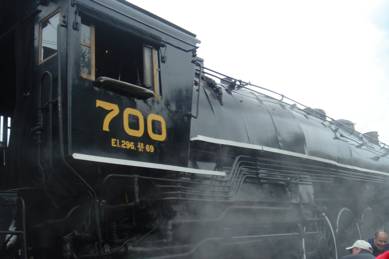
When she worked for the Spokane, Portland & Seattle, Engine #700 pulled the pre-Amtrak "Empire Builder" train through Oregon's Columbia Gorge. Photo by Edy Henderson
The City of Portland (which accurately describes itself as "The City That Works") owns two other historic steamers. Called "The Most Beautiful Engine in the World", the former Southern Pacific Daylight
GS-4 #4449, is one of them.
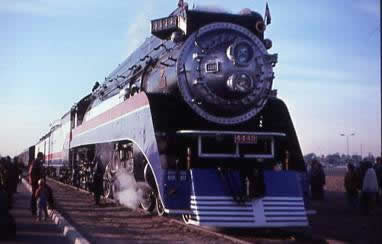
*Dubbed "The Most Beautiful Engine in the World" when working for the Southern Pacific, this 6,500 horsepower Art Deco streamliner looks good from any angle. Chris Guenzler photo for Trainweb
A third engine lives alongside the others, but is still under renovation. Former Oregon Railroad and Navigation #197 has 77" drivers, like the #700, but is less than half the weight of the larger locomotive.
Both the #700 and the #4449 bring a thrill to the hearts of everyone who is fortunate enough to see and hear them in action. All three engines occupy their new home adjacent to the Oregon Museum of Science and Industry known as OMSI.
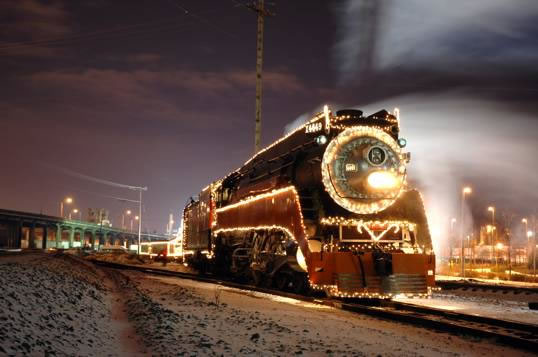
Dressed up for the Holiday Season, Engine #4449 is ready to carry Santa Claus and excited passengers
along a stretch of the Willamette River in Portland. OHRF Photo
The new Engine House was designed to look like a building from the 1940s.
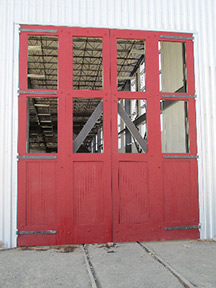
Vintage wooden doors, about 70 years old, give the engine house a look of 1940s authenticity.
It's a maintenance and restoration venue and a public viewing area, as well as a place to shelter the engines from the weather. From the new location, visitors can see across the Willamette River to Portland's tree-clad West Hills and the city's unusual skyline, featuring glass-curtained high rises of various colors.
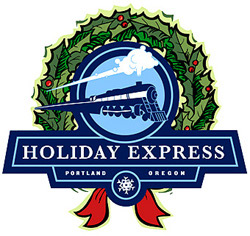
The festive ORHF Holiday Express is an annual event. Each of the working steam engines appears on alternate weekends to carry Santa Claus, candy canes, and excited kids of all ages in vintage passenger coaches Most of these wear the authentic 1940s-era Daylight colors of red, orange, and black.
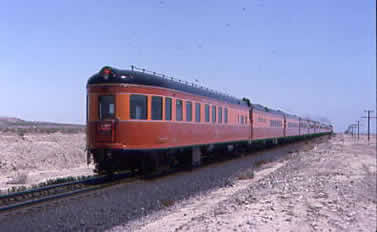
*This car once carried first-class passengers between Los Angeles and Seattle on the pre-Amtrak "Coast Daylight"
and between Oakland and Portland behind the "Shasta Daylight". Chris Guenzler photo for Trainweb
If you don't want to miss live steam action, consider this: Portland is a pleasant place to spend the holidays, and a good place for Christmas shopping. Department store windows display holiday themes. Elegant downtown hotels are decorated for the season. Although rain is frequent, the locals don't let that stop them. There are plenty of family activities, such as a brunch or dinner cruise on the Willamette River, which runs through the middle of the city. And of course, you'll have a priceless experience -- the rare chance to ride behind, and observe, a steam locomotive! Tickets are only $17 per adult.
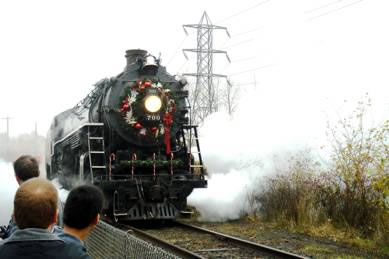
The day was chilly in December 2011 when we rode on OHRF's Holiday Express, but Engine #700 was a cheerful sight
as steam roared out of her cylinders. Edy Henderson photo
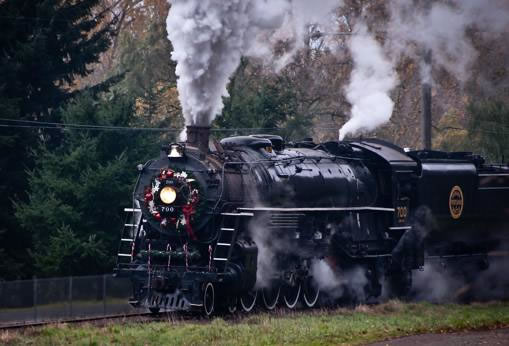
You can almost hear the husky steam whistle and the chuff-chuffs as #700 performs in front of the
Holiday Express. OHRF Photo
This year, each of the steam locomotives will star on alternate weekends: November 30th through December 2nd, December 7th through 9th, and December 14th through 16th. There are morning, afternoon, and evening departures. Tickets are available in advance from Tickets West at 1 503-224-8449 or www.ticketswest.com.
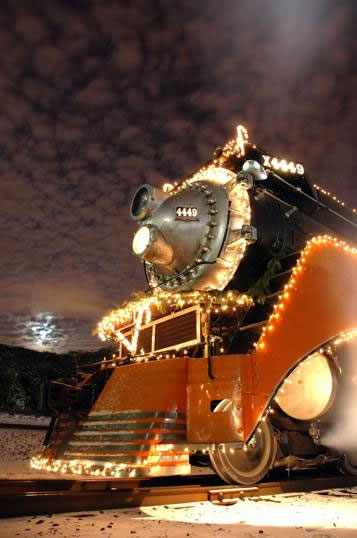
On a cold December night with a powdering of snow on the ground, the former Daylight engine warms up the night as she pulls the Holiday Express. OHRF photo
During the Holiday Express weekend, ORHF volunteers sell food and drink. They also provide a great opportunity to buy Christmas gifts, such as T-shirts, jackets, blankets, calendars, and other souvenir items featuring the engines. Profits go towards paying the remaining amount still owed for the Engine House. The items are displayed in a huge white heated tent -- a popular place to wait for your train, as the weather can be overcast and the wind chilly.
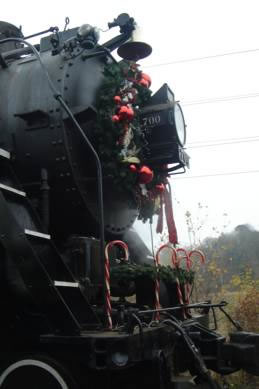
It was a cold and windy day, but the Holiday Express cars #700 is pulling cars that are all heated inside.
Edy Henderson Photo
The ORHF's goal has been to secure a permanent home, in conjunction with a rail and industrial museum, for the three historic engines, which had been stabled at Burlington Northern Santa Fe's Brooklyn Roundhouse. All three engines were handed their rolling papers when BNSF needed to expand, and were off the premises by January 2012.
BNSF announced this long before the deadline. The OHRF volunteers had over 13 years to raise the needed funds ($5.949 million) to accomplish this ambitious project. As of press time, according to www.ohrf.org, they had achieved $5.014 million. As well as soliciting donations from readers of their newsletter, the group mobilized nearly a dozen foundations; the BNSF Foundation and the Union Pacific Foundation both contributed. Additionally, several corporations were tapped, as well as private individuals.
Someone once said, "All steam engines are bad actors". This describes them perfectly! They do go to extremes while making heavy weather of every action, and do a great job of convincing humans that they, too, are living, breathing creatures.
Now gather around, young folks, and I'll share my memories about the historic era called "The Age of Steam".
First off, none of the steam engines of my acquaintance "chugged". They "chuffed".
San Luis Obispo, California, where I grew up, is halfway between San Francisco and Los Angeles, and was a crew change and watering stop for steam engines. Southern Pacific was the only rail company that came through town. Passenger steam engines chuffed through twice daily hauling what we called the noon “Daylights", as that was when both the northbound and southbound “Coast Daylights” were in and out of town between 11:45am and 12:30pm.
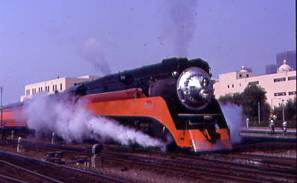
The last remaining engine of her design, the #4449 pauses for photos. My father worked as a fireman on an engine like this one in the 1940s. Chris Guenzler photo for Trainweb
(The overnight “Larks” arrived between 1am and 2am.) Helper engines were added, or removed, at the yards next to the station, south of downtown, and were necessary because of the steep climb over the scenic Cuesta Grade.
If we were stopped at a grade crossing in town, we'd marvel at the brilliant red, orange, and black livery the GS engines wore. The scheme was designed by SP to show off well against the California hills and mountains.
We saw white jacketed waiters in the diner, and spiffy attendants in maroon and gray uniforms, waiting graciously on the fortunate passengers. Through the plate-glass windows one could view fresh flowers waving gently atop the linen-covered tables. The Daylight sported a neon drumhead on its round-end parlor observation car, which made quite a memorable "CLICK-click......... CLICK-click" as the train pulled smoothly away from the San Luis Obispo Station.
SP's engines were clean oil-burning machines producing no cinders.
The distinctive whistles of the helper in front of the passenger engines were surpassed in volume by the night-time freights pulled by muscular four-cylinder Mallet steam engines. The Mallet's pile-driver like pounding and syncopated vibrations from its dual engines shook the foundations of our house only blocks away.
My father worked as a fireman on the GS passenger engines in the early 1940s. He'd come home wearing bib overalls, his face smeared with oily soot. And he loved every minute of it!
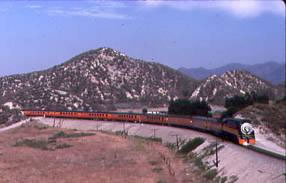
Recreating the Age of Steam, #4449 was pulling a train in matching colors for a special passenger excursion as she showed off her 6,500 hoursepower engine. Chris Guenzler photo Trainweb
Sometimes we'd drive past the railroad yard on frosty mornings where helper engines were steamed up and ready to go. "This steam's so thick you could walk on it", Dad would say.
We rode on the Coast Daylight only once. Some vivid memories include chuffing sounds as the two engines rounded the Horseshoe Curve and marched up the Cuesta Grade. Far from the highway atop the Santa Lucia mountains, we had a bird's eye view of the miniature volcanic peaks near San Luis Obispo as well a glimpse of the ocean miles away. A unique individual known as the "candy butcher" went up and down the aisles offering items such as candy bars, magazines, and cigarettes for sale. (Yes, there was a time when smoking was permitted on board.)
Meanwhile, my husband Ted was growing up near Pittsburgh where various trains burning coal ran along four track main lines on both shores of the Ohio River. His only experience with California's Coast Daylight arrived from the grocery store, as a cardboard cutout on a box of Kellogg's Pep breakfast cereal. He put it together, and kept it on the dining room mantelpiece, intrigued by its bright colors and streamlined appearance. But he never dreamed he'd get to see it, nor, of course, could he imagine that his future wife was watching those trains go by twice a day.
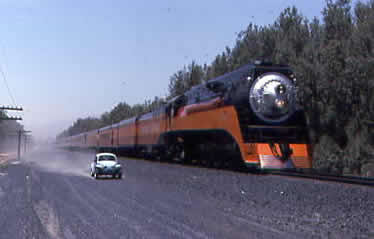
The VW gives some scale to the size of the #4449 engine, all 433 tons of her.
Chris Guenzler photo Trainweb
SP was a late adapter of dieselization, and maintained the steam engines into the mid-1950s. But the glamour begin to fade and the GS engines were eventually painted a flat black; the company concluded that keeping the colorful paint job shiny and clean was too labor-intensive.
I was too busy being a teenager in the 1950s to notice the changes. After moving to the San Francisco Bay Area, where there were other railroads and diesel engines, I forgot about steam. It wasn't until 1958 on a cross-country drive that I saw the depressing scenario of derelict steam locomotives abandoned all along the way. I was shocked to realize that the age of steam was over -- I thought steam and diesels would always co-exist.
An acquaintance later told me about watching the GS engines being junked and systematically broken up by SP. Only one GS engine, #4449, was rescued from the scrappers. She was donated by the Southern Pacific to the City of Portland and languished at the city’s Oaks Park in static display from 1958 until 1974 when she was restored in order to claim her second career as the Bicentennial American Freedom Train in sparkling red, white, and blue livery.
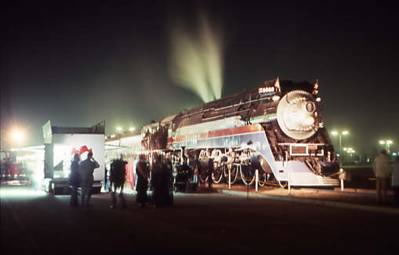
Coming out of retirement in order to pull the 1976 "Bicentennial Freedom Train" throughout the US, #4449 is dressed in patriotic colors. Her 80" drive wheels sport white sidewalls. Trainweb photo by Chris Guenzler
By this time, Ted and I were together and he had the chance to see his dream train for real. We waited next to the SP tracks early one morning, craning our necks for the first hint of a steamy plume. Then #4449 pulled the Freedom Train through Menlo Park, California, -- what a statement she made! By the 1970s a generation of kids had grown up without ever seeing or hearing a steam engine. Wide-eyed, they too were lining the tracks with their dads
.
Built in 1941 to pull the "Daylight" passenger trains, #4449 worked for the Southern Pacific until 1955, then retired to Oaks Park in Portland until being restored by the all-volunteer Friends of the SP 4449 and repainted in red, white, and blue. Chris Guenzler photo for Trainweb
I was delighted to see my old friend, #4449. And while she has a bit more horsepower and boiler pressure than the #700 -- and three-inch higher drive wheels -- she is truly a lady. She is sleek, art deco, and streamlined. She's got the kind of beauty you can't tear your eyes away from.
Let's fast forward to December 2011. SP&S Engine #700 is waiting for us to board her train!
Ed Immel, Vice President of ORHF, was hosting PTJ that day in December, 2011. Ed is a thoroughly railroad person. When he worked for the Oregon Department of Transportation he rode over every inch of rail and every public grade crossing in the state. Later he worked on the Freedom Train project, and signed the check to pay for moving #4449 out of Oaks Park and into the area where she was painstakingly restored to begin her second career as the Freedom Train.
As the #700 got underway we were completely enveloped in a cloud of steam. When it cleared, there were lots of awe-struck people looking our way.
Santa made his way through the train, handing out candy canes and getting people in each car to start singing Holiday Carols.
After our 45 minute trip, we detrained and watched the passengers for the next trip get aboard. This time we'd see the engine at work from the outside. With a deafening whoosh-whoosh, steam roaring out of the cylinders was carried by a windy gust that nearly knocked us off balance.
"Woosh, swish..........woosh, swish" continued until a whispered "Chuff" started as the train crept forward. As the chuffs got louder and closer together, she whistled off with a husky, wavering cry.
The last remaining SP round-end parlor observation car brought up the rear, #2955, built in 1941 for the Coast Daylight and reassigned in 1949 to the Shasta Daylight. Immel told us this car had been in a fire and was covered with fire-fighting foam when they acquired it. A complete restoration was completed, followed by a fresh coat of the authentic Daylight colors.
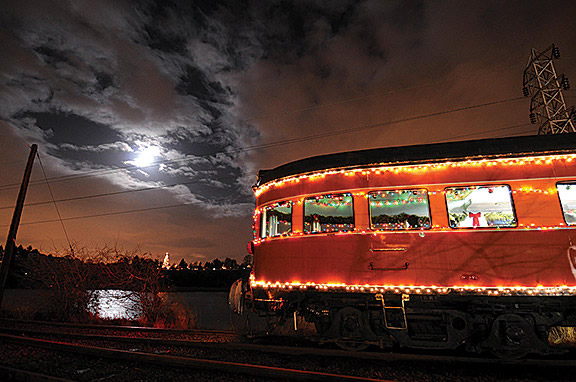
The last remaining Parlor Car from Daylight days, this carriage was in ruined condition until
being saved by the OHRF. OHRF Photo
As the car slipped away, it made that same rhythmic "CLICK-click......... CLICK-click" I remember so well when Car #2955 made that very same classy sound in San Luis Obispo, during The Age of Steam.
OHRF's engines can be found, unless they are out on an excursion, at their Engine House located at 2250 SE Water Avenue, Portland OR 97214. However, if you Google Map that you'll wind up in the wrong place. The entrance is at SE Caruthers and the Hwy 99 (Grand Avenue) Viaduct.
The organization's web site is at www.ohrf.org. You can leave a message at 1 503 233 9706.
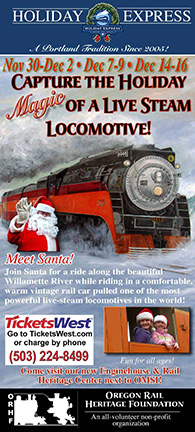
|